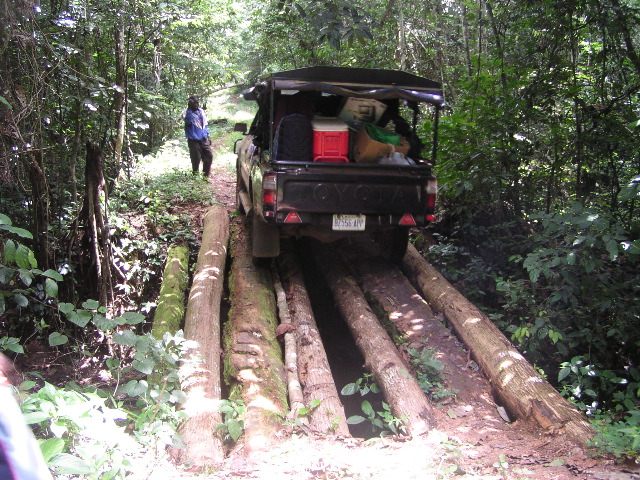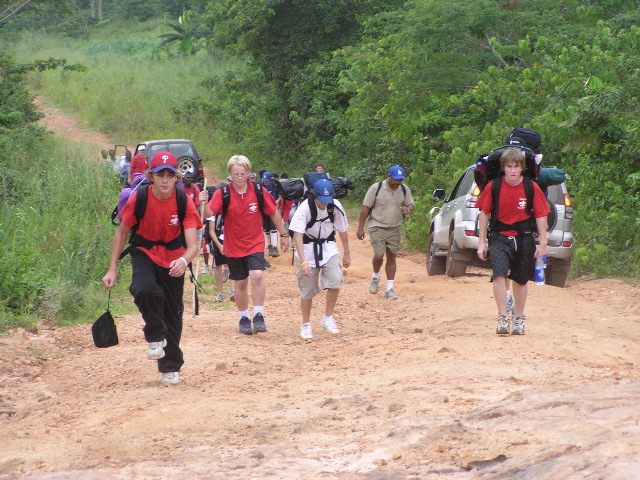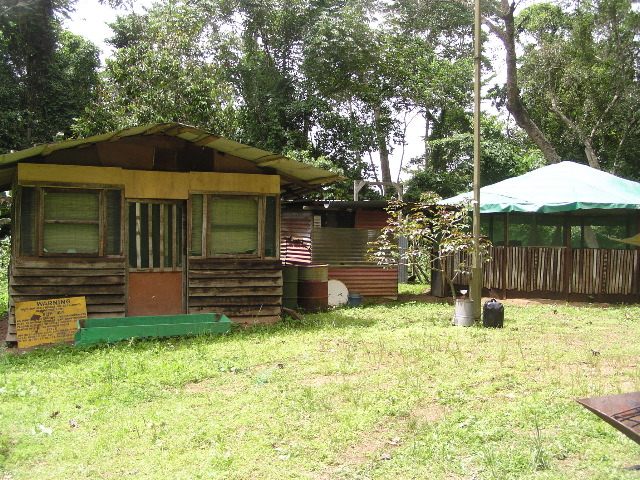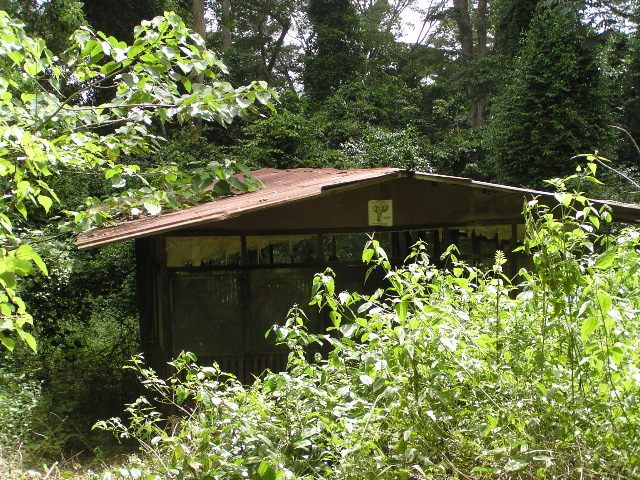Trip to: A TRIP TO OMO FOREST (AND HOW WE LEARNED TO MAKE BANANA BOATS)
Date: Saturday, May 21st 2005
Trip leader: Gunther Kleinoeder
Trip report: Hugh Campbell
At 7.15 am on an overcast and steamy Saturday morning we gathered outside the imposing walls of Fortress Chevron.
We were quite a crowd. Starting with the members of the Field Society, we were:
Gunther Kleinoeder ( the team leader ) and his two sons, Nicholas and Kai, Mike Newton, Arnulf Ziems, Steve and Sara Dobbs and their son, Erin. (Steve was there in his capacity as the Scout Master for Troup 803 ), and Hugh and Robin Campbell (Robin was there in her capacity as Field Society Trip Food Manager).
Then we had Boy Scout Troup 803,consisting of 12 boys between the ages of 11 and 15 and five adult team leaders. And last, but certainly not least, three Alfa Papas (armed police, to the uninitiated).
At about 8.15 our convoy headed off in the direction of Epe. The bus full of scouts went first, followed by a Chevron Landcruiser, then our own Landcruiser. The Alfa Papas brought up the rear in a pickup truck. Gunther went ahead in a vehicle kindly lent to him by Robert Warren. Thank goodness for the Alfa Papas! There were 28 checkpoints in the first two hours; however we sailed past all of them . The Alfa Papas communicated with each checkpoint by emitting a strange combination of toots from the horn and growls from the siren .The language was certainly well understood !
We plodded along at a fairly sedate ( but safe ) 80km per hour, in compliance with the rules for operating the bus. Despite our slow speed, one of the Landcruisers very soon started to overheat, so there were frequent stops to allow for cooling down . About three hours later, we limped into a small village on the edge of Omo Forest.
The bus disgorged its young passengers, plus an astonishingly large amount of food, water, and camping equipment. The scouts and troup leaders hoisted their backpacks onto their backs and started the long, hot and hard 16 km hike to the Omo camp. The convoy of vehicles (minus the bus) followed at an even slower rate than before, carefully navigating its way over some highly challenging log bridges.

One of the log bridges on the way to the camp

The Boy Scouts at the start of their trek
Within a few kilometres, it became apparent that one Landcruiser could not make the hills, so we unloaded the camping equipment into the police truck, and continued for another 10 kilometers, until the police truck got stuck in the thick mud. Fortunately we were only about 200 meters from the camp, so we were able to carry the equipment in by hand . We arrived at the camp at about 2 pm. The camp is attractively situated in a clearing on top of a knoll in the forest.

Erin Camp accommodation
It consists of three wooden chalets and an outdoor table covered by a roof for eating. There is also a small kitchen with a sink and the remnants of a gas stove. Behind the kitchen is a shower stall in which someone has created an ingenious shower using a bucket with a tap and shower head screwed into the bottom, all of which can be raised or lowered using a small winch.
Gunter had arrived a few hours earlier, and was busy repairing a wooden bed, using some highly original tools. Robin, who had brought enough food to feed several famished armies, prepared sandwiches for lunch.
After lunch we decided to do a bit of exploring. Not far from the camp, nestled in thick forest, is a building that was once a school. Inside it is full of mostly broken desks and chairs that had been donated by the German school in Lagos. There is also a strange white papier mache elephant that sits somewhat forelornly on a corner of a dirty desk.
Although the building and the furnishings appear to be very old, a small bronze plaque lying on the floor attests to the fact that the school was in fact commissioned as recently as 1996! It is hard to imagine why anyone would choose to build a school in such a remote area, but therein lies a tale, which, perhaps, the white elephant could tell us.

Erin Camp Schoolroom (before the work started)
(ahem,… white elephant here: the building has been used to bring in school children from the surrounding villages, to learn about conservation, especially the need to protect the few remaining forest elephants in the area. ‘Erin’, the name of the camp, is the local name for Elephant)
We left the school and walked along a reasonably well cleared path into the forest. The trees were truly majestic and magnificent, with incredible flying-butress trunks.
One tree in particular warrants a special mention. At some point in its life someone tried, and almost succeeded, in cutting it down. The tree now bears massive scars around its base as a dramatic testament to its will to survive.
On our way out of the forest we noticed that the path was alive with tiny beautiful red flowers, rather like miniature porcelain roses. We returned to the camp just as the boy scouts arrived. It had taken them about three and a half hours to walk 16 kilometers, which was very good considering the heat and the heavy backpacks .They immediately erected half a dozen tents, and created a kitchen area.
After a short break, we broke into two working parties. One group cleaned out the school, and the other group cleaned the area around the camp. A bonfire was lit to burn the worst of the garbage.
Then it was time for dinner. Robin had made tons of delicious chile con carne, which only required heating. The scouts obliged by producing two wonderful primus stoves, which operated on normal petrol.
After dinner, the scouts treated us to a bonfire and a programme of skits and jokes, all professionally organised by a master of ceremonies. However the highlight of the evening was a tribute to Steve, delivered with truly heartfelt candour, by a young scout. A truly remarkable evening!
Sunday, May 22nd, 2005
We awoke at about 6.30 am after a very comfortable night, at least for us. Apparently, in one of the tents, there had been a bit of a battle with a giant spider, but the scouts had prevailed.
Gunter unknowingly put on a demonstration as to how to use the shower, and the scouts introduced us to a new breakfast delicacy—-the Banana Boat. To make a banana boat, you carefully slit a banana lengthwise in its skin halfway through. Following this, you stuff the banana with marshmallows and then add sticks of chocolate. You then bake the banana, still in its skin, over an open fire for five minutes. The result is, well, an interesting early morning energy boost !
Following breakfast, we broke into two groups .Gunter headed off with one group in a car with a guide to climb a nearby mountain . Unfortunately, they never made it . The vehicle was soon mired in mud so thick that it had to be repeatedly jacked out.
The second group walked out with the scouts, which was very pleasant .. While walking one could not help but notice how much logging was taking place. The sides of the road were covered with giant logs waiting to be towed out.
Eventually, we all met at the village by the edge of the forest, and, armed with fresh Alfa Papas, in a new vehicle, we cruised back at 80 kilometers per hour , tooting and growling all the way to Lagos
